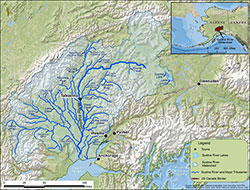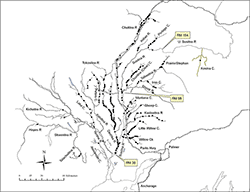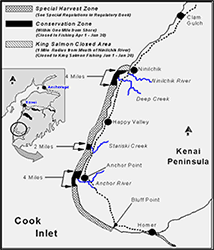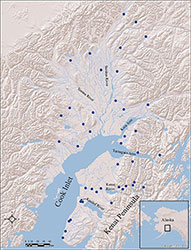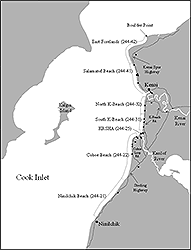Chinook Salmon Research Initiative
Susitna River Chinook Salmon
Susitna River
Overview
The Susitna River is a glacially-fed river system located near Anchorage, Alaska that drains into upper Cook Inlet. The total run of Chinook salmon to the Susitna River is unknown, as no comprehensive harvest and escapement programs have ever been conducted. In 1985, the Alaska Department of Fish and Game conducted a mark-recapture project and estimated the escapement of Chinook salmon to the Susitna River drainage at 113,931 fish greater than 400 millimeters (15.75 inches) in length. This is the only drainage-wide Chinook salmon escapement estimate for the Susitna River. Instead, Chinook salmon escapements in the Susitna drainage are monitored annually by the department with single aerial (helicopter) surveys on 12 clearwater tributaries and one tributary weir (Deshka River). These surveys provide an index of escapement rather than a complete census of the escapement.
Chinook salmon counts at the Deshka River weir were consistently over 20,000 fish from 1997 to 2006, but since then have been less than 20,000 fish, and the count was below the minimum escapement goal in 2008 and 2009
Most of the harvest of Susitna River Chinook salmon is by the inriver sport fishery. A directed set-gillnet commercial fishery occurs off the mouth of the Susitna River, and the Tyonek subsistence fishery occurs in marine waters about 20 miles from the mouth of the Susitna River. The contribution of the Susitna River stock to these fisheries has never been estimated, but the total harvests of both these fisheries are relatively small compared to the sport harvest and escapement data. The department has established a genetic baseline for Chinook salmon stocks throughout Cook Inlet, and was awarded an Alaska Sustainable Salmon Fund grant to begin sampling some of the marine harvests of Chinook salmon in Cook Inlet in 2014.
Adult Spawning Abundance
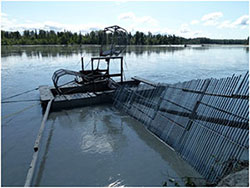
From 1977-1985 the Alaska Department of Fish and Game conducted environmental studies as part of the Alaska Power Authority's project to build a hydroelectric dam at Devil's Canyon on the Susitna River. Chinook salmon escapements drainage-wide were estimated in 1985. Timing and age, sex, and length of Chinook salmon escapements were documented in fish wheel catches at Sunshine (lower river), Talkeetna (middle river), and Curry Stations (middle river) in 1981, 1982, and 1983. Radio telemetry was used in 1981 and 1982 to track the migration of fish tagged at Talkeetna Station (middle river). Chinook salmon spawning habitat suitability was modeled 1984.
In addition to the escapement indexing, the Alaska Department of Fish and Game and private consultants conducted environmental assessments in 2012 and 2013 for the proposed Susitna-Watana Hydroelectric project. In 2012, department crews operated fish wheels in the mainstem Susitna River to radio tag Chinook salmon and track the tagged fish to locate spawning sites using stationary telemetry receiver-loggers and aerial surveys. The results of the 2012 Chinook salmon spawning distribution study identified spawning locations within the Susitna upstream of the Yentna River.
In 2013, Chinook salmon were radiotagged on the mainstem Susitna River and the Yentna River to estimate the drainage-wide escapement. Weirs at the Deshka River and Montana Creek, and sonar at the Chulitna and Talachulitna rivers, along with telemetry receivers at each site, were used to sample the escapement for tagged and untagged fish. The Chinook salmon escapement for the mainstem Susitna River was estimated at 89,463 fish, with 18,469 (21%) going to the Deshka River (Table 1). An abundance estimate could not be generated for the Yentna River as sampling was insufficient. The Chinook Salmon Research Initiative recommends continuing this study to improve knowledge of abundance, run timing, and distribution of spawning Chinook salmon in the Susitna River drainage. This information is critical to ultimately using annual helicopter aerial escapement index surveys and weir counts from selected Susitna River tributaries to reconstruct and annually monitor drainage-wide abundance and escapement of Susitna River Chinook salmon.
Chinook salmon spawning distributions, based on weighted abundance, in the mainstem Susitna River above the lower river tagging site (confluence of Yentna River), 2013.
| Location | Estimated Abundance | Standard error | Intervals | |||
|---|---|---|---|---|---|---|
| 95% lower | 95% upper | |||||
| Susitna River above the mainstem tagging site | 89,463 | 9.523 | 77,720 | 114,954 | ||
| PRMa 34–102.4 mainstem Susitna River b | 2,432 | 259 | 2,112 | 3,124 | ||
| Deshka River | 18,469 | 1,573 | 16,643 | 22,801 | ||
| Eastside Susitna Rivers | 16,867 | 1,873 | 14,541 | 21,860 | ||
| Talkeetna River | 24,408 | 3,008 | 20,619 | 32,362 | ||
| PRM 102.4–153.4 mainstem Susitna River c | 7,680 | 898 | 6,560 | 10,066 | ||
| Chulitna River | 19,607 | 2,161 | 16,907 | 25,352 | ||
| a PRM is the rivermile for the proposed Susitna-Watana hydroelectric project. b PRM 34 upstream to the Chulitna River Confluence c Chulitna River Confluence to Devils Canyon |
||||||
In the spring of 2014 the Alaska Department of Fish and Game will be installing a floating fish weir on Alexander Creek. This project will quantify returning adult Chinook and coho salmon to the creek where an invasive northern pike suppression project is on-going. Alexander Creek was once a productive and popular Chinook salmon fishery. Predation by invasive northern pike in Alexander Creek has led to significant declines in salmon production, and Alexander Chinook salmon is now a stock of concern. This weir project will accurately estimate Chinook and coho salmon abundance returning to the creek and improve evaluation of the northern pike suppression program. The objectives for this project in 2014 are to count the Chinook and coho salmon escapement to Alexander Creek, and estimate the age and sex composition of the Chinook and coho salmon escapements to Alexander Creek.
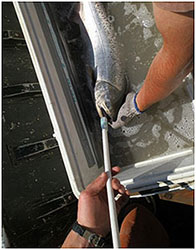
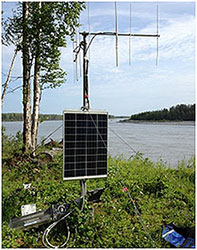
Juvenile Abundance
Between 1978 and 1984, Alaska Department of Fish and Game conducted numerous juvenile Chinook salmon studies in the Susitna River as part of the Alaska Power Authority's proposed project to build a hydroelectric dam at Devil's Canyon on the Susitna River.The movement and distribution of juvenile Chinook salmon in the lower and middle Susitna River was documented in 1978 and 1981. In 1982, 1983, and 1984 juvenile migration and distribution studies concentrated on the middle river.
The department currently does not conduct any juvenile Chinook salmon assessments on the Susitna River. Localized studies of juvenile salmon distribution were conducted in 2013 by private consultants as part of the environmental assessments for the proposed Susitna-Watana Hydroelectric project. The department conducted smolt marking feasibility studies during 1993-1997 that concluded Willow Creek (a Susitna River tributary) was the most suitable stock to describe the marine harvest of upper Cook Inlet Chinook salmon. During 1997-2002 juvenile Chinook salmon in Willow Creek were marked with coded wire tags and a weir was operated for adult Chinook salmon on Willow Creek to estimate the marked fraction. Salmon harvests were sampled as far away as Kodiak Island, and the contribution of Willow Creek Chinook salmon to marine commercial and sport fisheries was intermittent and low.
From 1996 to 1998, a total of 270,510 wild Willow Creek juvenile Chinook salmon were marked with coded wire tags, resulting in marked fractions of 2.6%, 1.3% and 3.6% for the 1995, 1996, and 1997 brood years, respectively. From 1994 to 1996, 25% of hatchery-reared Chinook salmon smolt released into the Willow Creek drainage were also marked with coded wire tags, and from 1997 to 2000, 100% of approximately 200,000 Chinook salmon smolt released annually were marked with coded wire tags.
Catch sampling was used to estimate the contribution of tagged stocks to Cook Inlet commercial and recreational marine fisheries, Kodiak marine commercial fisheries, and the Willow Creek recreational fishery and spawning escapement. One wild Willow Creek Chinook salmon tag was recovered in the Kodiak marine commercial fishery in 1998 for an estimated harvest of 80 fish, one was recovered in the Central Cook Inlet marine recreational fishery in 1999 for an estimated harvest of 100 fish, and one was recovered in the Upper Cook Inlet Northern District set gillnet fishery 2001 for an estimated harvest of 37 fish. Harvest of hatchery Chinook salmon in the Kodiak marine fishery ranged from 11 to 20 fish during 1997-1999, in the Central Cook Inlet marine recreational fishery harvest ranged from 9 to79 hatchery Chinook salmon during 1996-2002, and in the Cook Inlet Northern District commercial set gillnet fishery harvest ranged from 10 to 41 hatchery Chinook salmon during 1997-2002. The majority of hatchery Chinook salmon returning to Willow Creek were caught in the inriver recreational fishery for which they were intended. Harvests ranged from 912 to 2,307 hatchery Chinook salmon in the Willow Creek recreational fishery from 1997 to 2002.
Two wild, Willow Creek coded wire tags were recovered in the bycatch of federally managed groundfish fisheries (Gulf of Alaska, Aleutian Chain, and Bering Sea) during 1997-2002, but available catch sampling information did not allow calculation of the harvest contributions.
Marine Sampling
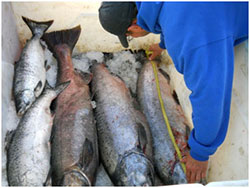
Adult Chinook salmon returning to the Susitna River in Southcentral Alaska provide both sport and commercial harvest opportunities in several marine and inriver fisheries. Each year, the Alaska Department of Fish and Game assesses these returns by conducting research to estimate run sizes in the Susitna drainage through weirs, creel surveys, harvest sampling, or mark-recapture techniques. Recent low Chinook salmon runs in this system has heightened concerns about stock-specific harvests in mixed-stock marine fisheries. Fortunately, recent advancements in genetic stock identification techniques of Chinook salmon allow for discriminating between discrete Chinook stocks in mixed-stock fishery samples. These advancements led to the development of a genetic baseline database for Cook Inlet Chinook salmon using collections from 42 locations and other stocks in the Gulf coast of Alaska (Olive et al. 2013 - PDF 736 kB).
Two marine sport fisheries harvest Chinook salmon in Cook Inlet; one occurs along the eastern shore of central Cook Inlet from late April through mid-August and another that occurs year-round out of Homer. Past attempts at estimating the stock-specific harvests of Chinook salmon in the central Cook Inlet marine sport fishery using coded wire tags were incomplete due to low precision of estimates and poor or limited tagging of wild Chinook salmon stocks. The stock-specific harvest of sport caught Chinook salmon out of Homer is also poorly described. Since the 1990s both fisheries have been sampled for maturity and age, sex, length composition information and also for coded wire tag recoveries, but not for genetic stock identification purposes. Recent estimates of the number of Chinook salmon harvested each year in these fisheries averages about 6,587 fish. A project to estimate the stock-specific harvest for the first time using genetic stock identification techniques in these fisheries is set to begin in 2014.
A commercial fishery in Upper Cook Inlet harvests Chinook salmon in late-June through mid-August while targeting more abundant sockeye salmon. In particular, the East Side set gillnet fishery, located along the eastern shore of Upper Cook Inlet between Ninilchik and Boulder Point, (Eskelin et al. 2013 - PDF 1,409 kB) harvests the majority of Chinook salmon caught in the Upper Cook Inlet commercial fishery. Each year, the fishery harvests approximately 9,600 Chinook salmon, although recent harvests have been below average. On average, the East Side set gillnet fishery accounts for about 2 of every 3 Chinook salmon harvested in the Upper Cook Inlet commercial fishery. Harvests of Chinook salmon in the East Side set gillnet fishery have been sampled for age, sex, and length composition information, and since 2010 tissue samples for genetic analysis were added to the collection effort. Alaska Department of Fish and Game biologist will be sampling the East Side set gillnet fishery for age, sex, length composition, genetics, and coded wire tag information in 2014.
Stock-specific harvest information in these fisheries is needed to improve the understanding of stock productivity, assist in development of brood tables for long-term stock assessment, and for adjusting escapement goals for stocks in the Susitna drainage. These fisheries account for the bulk of Chinook salmon harvested in Cook Inlet marine waters. In forthcoming projects, the department will be sampling the harvest of Chinook salmon in these fisheries for genetic tissue in order to estimate the stock composition.
Sport fishing for Chinook salmon occurs year-round in Cook Inlet marine waters though most of the harvest occurs during the months of April through August. The majority of this marine harvest is landed in the ports of Homer, Anchor Point and Deep Creek / Ninilchik beaches. Beginning in 2014, Alaska Department of Fish and Game technicians will collect samples at each of the major access points (the Homer Harbor, Anchor Point tractor launch and marine access area, and Deep Creek tractor launch and marine access area) during the summer fishing season (April–eptember) and while the tractor launches are operating. During the winter fishery (October–March), samples will be collected from fish harvested in the Homer fishing derbies and as weather allows. All available Chinook salmon encountered will be sampled for genetic tissues, coded wire tags, and age, sex and length information. Technicians will collect samples from as many Chinook salmon as possible while attempting to distribute effort between private and charter fishing vessels.
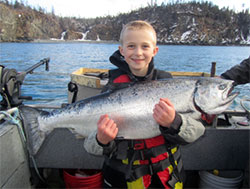
In the absence of stock-specific harvest information for this fishery and based on harvest and sample sizes available during the summer and winter fisheries, genetic reporting groups chosen for this fishery are "Susitna River" (including the Yentna River, Susitna River, and Western Cook Inlet populations), "Kenai River" (including Kenai River mainstem and tributary populations), "Other Cook Inlet" and "Outside Cook Inlet". The "Other Cook Inlet" reporting group includes Cook Inlet populations from Turnagain Arm, Knik Arm, Kasilof River, and southern coastal Kenai Peninsula streams (Anchor River, Deep Creek, Ninilchik River and Stariski Creek). Estimates of Chinook salmon stock composition and harvest by reporting group will be stratified geographically by fisheries occurring north and south of Bluff Point in Kachemak Bay (59°40'N), and temporally based on management criteria.
During and after East Side set gillnet fishery openings, Alaska Department of Fish and Game technicians will sample available Chinook salmon for genetic tissue, age, sex, and length composition information, and coded wire tags at receiving sites for fish processing plants after each tide. Technicians will collect as many Chinook salmon samples as possible, at as many receiving sites as possible, many sites being sampled more than once. Chinook salmon genetic samples were collected over four years (2010–2013) from fish harvested and sold from the East Side set gillnet fishery. A mixed stock analysis was performed on tissue samples collected in 2010, 2011, and 2013; however, an analysis was not performed on tissue samples collected in 2012 due to small sample size. Geographic locations within Cook Inlet were identified to apportion the sampled harvest, which were: "Kenai River mainstem", "Kenai River tributaries", "Kasilof River mainstem", and "Cook Inlet other". The Cook Inlet other reporting group represented all remaining Cook Inlet Chinook salmon baseline populations not included in the three other reporting groups, which includes populations within the Susitna River. Reporting groups were defined based on one or more of the following criteria: 1) the genetic similarity among populations, 2) the expectation that proportional harvest would be large (>5%), or 3) the applicability to answer fishery management questions.
Results from the mixed stock analysis of harvest samples collected in 2010, 2011, and 2013 revealed that, on average, Kenai River mainstem Chinook salmon composed the majority (69%) of the East Side set gillnet Chinook salmon harvest. These results are published in a Fisheries Data Series Report (Eskelin et al. 2013 - PDF 1,409 kB).
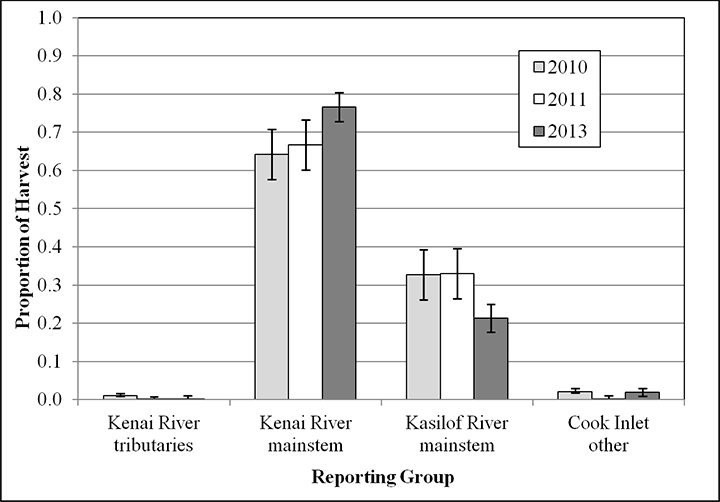
Prior to these analyses and lacking stock-specific harvest estimates, the harvests were treated as though all Chinook salmon harvested in the East Side set gillnet fishery were of Kenai River mainstem (late-run) origin even though it was known that other stocks, such as Kasilof River mainstem spawning fish, were harvested. In 2013, with additional funding through the Alaska Statewide Chinook Salmon Research Initiative, sampling was increased to allow for time and geographic stratification of stock-proportion estimates. Sampling of this fishery for mixed stock analysis will continued until the Alaska Department of Fish and Game can confidently assess the variation in stock proportions with respect to geographic and timing characteristics of the harvest.
Subsistence
The only in-river subsistence fishery in the Susitna Watershed occurs with fish wheels in a portion of the Yentna River; no Chinook salmon may be retained in this fishery. A marine subsistence set gillnet fishery occurs in the Tyonek Subdistrict, about 20 miles southwest of the mouth of the Susitna River. The Board of Fisheries has set the amount reasonably necessary for subsistence for this fishery at 750-2,750 Chinook salmon. Most participants come from Tyonek, with the remainder from other Cook Inlet communities.
Historically, most salmon (82%) harvested in the Tyonek fishery are Chinook salmon.
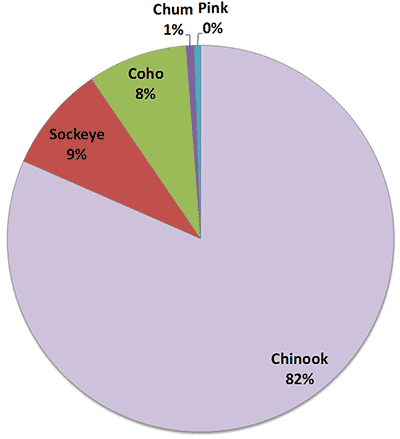
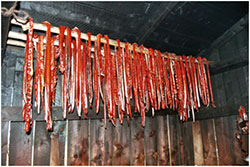
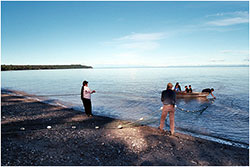
In the 1980s and between 2004 and 2006 the Alaska Department of Fish and Game conducted ethnographic studies in Tyonek. Researchers assisted households while they harvested and processed salmon, and conducted in-depth interviews about historical and contemporary uses wild resources. The department also conducted comprehensive harvest surveys in 2006 and 2013, as well as a salmon survey in 2011 which focused on the role of the commercial and subsistence fisheries in the economy and way of life of Tyonek.
Based on these studies, and concerns by fisheries managers and Tyonek residents about the declining abundance of Chinook salmon, a project will take place in 2014-2016, funded by the Alaska Sustainable Salmon Fund, to collect genetic data for fish harvested in the subsistence fishery and pair this with local knowledge of Upper Cook Inlet Chinook salmon stocks.
- Google+

